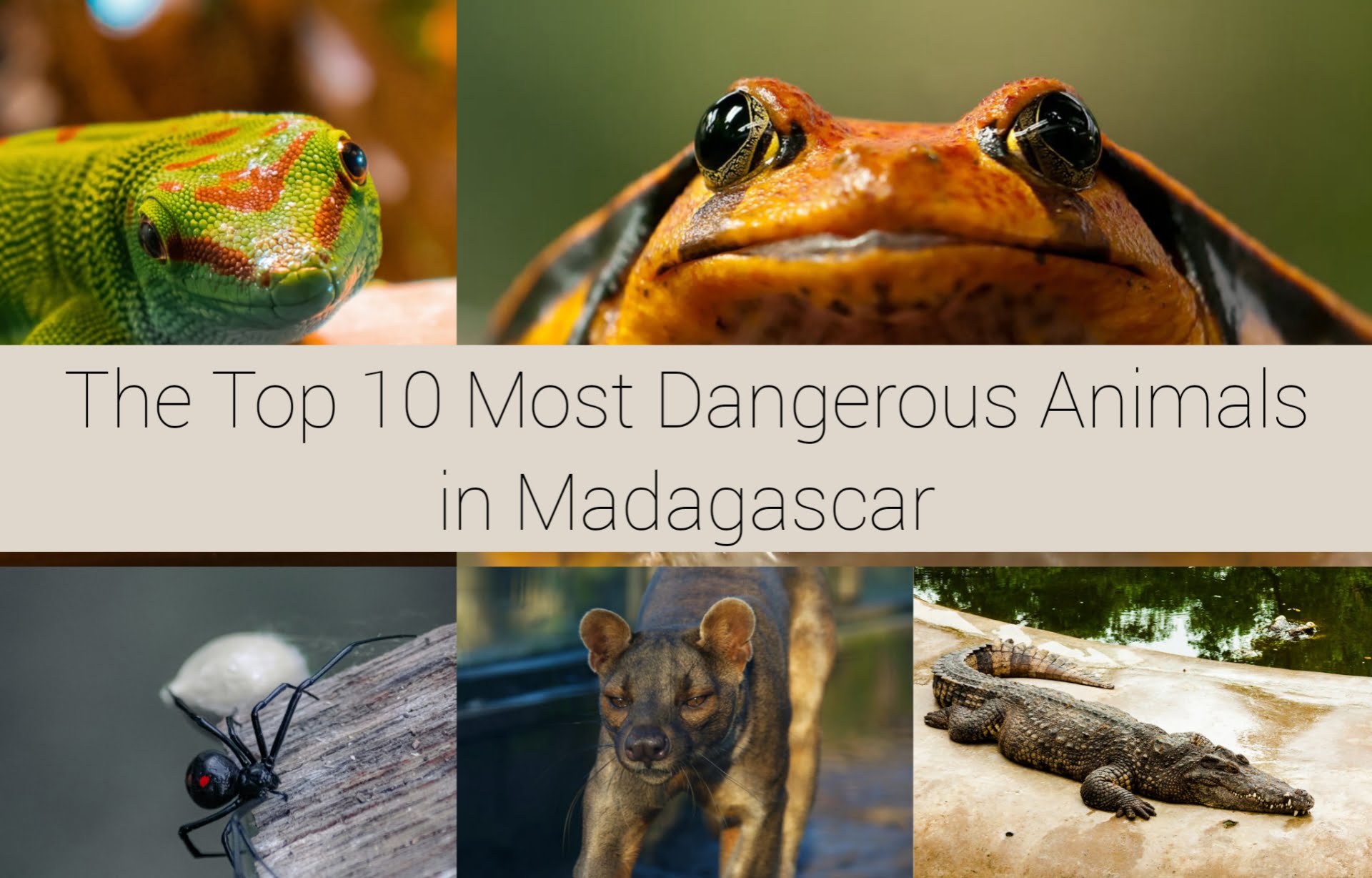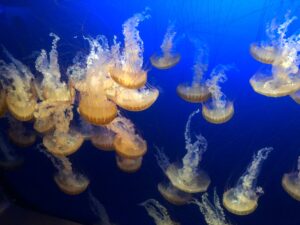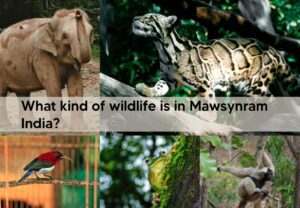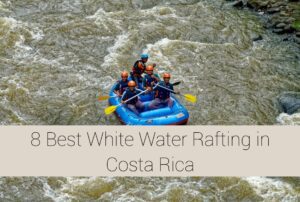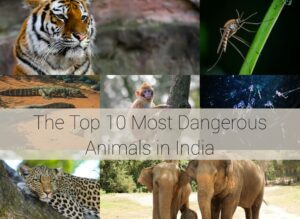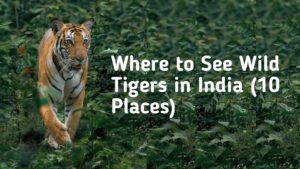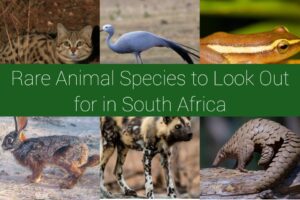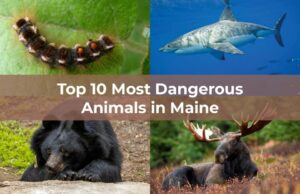When we talk about wildlife, the name Madagascar always comes up, mainly because of the animated film with the same name.
Madagascar is a beautiful island country in the Indian Ocean, off the coast of Africa. It is famous for its unique wildlife population, such as lemurs.
Just like many other countries that are known for their wildlife, Madagascar is also home to some animals that can be very dangerous and even deadly to humans.
In this article, we will look at the top 10 most dangerous animals in Madagascar.
The Top 10 Most Dangerous Animals in Madagascar
1. Nile Crocodile

Scientific name: Crocodylus niloticus
Habitat: They live in rivers, lakes, swamps, and mangroves.
The first animal on this list is the Nile crocodile. This crocodile species is the largest crocodilian that is native to habitats in Africa.
They are found in rivers, lakes, swamps, and mangroves in Madagascar. Nile crocodiles can grow up to 6 meters long and weigh up to 1000 kilograms.
They have a powerful bite that can crush bones and tear flesh off their prey, such as fish, birds, and other large animals like zebras and humans.
Luckily, these animals are rarely seen around your home in Madagascar unless you stay close to their natural habitat. The best way to avoid the Nile crocodile is to stay away from the water and never swim or fish in areas where they might be present.
2. Fossa

Scientific name: Cryptoprocta ferox
Habitat: Forest
The fossa is the largest carnivorous mammal in Madagascar. It looks like a cross between a cat and a dog, but it is related to mongooses.
This animal can grow up to 2 meters long and weigh up to 12 kilograms. It has sharp teeth and claws that it uses to hunt its prey. They live mainly in forests, where they climb trees and jump from branch to branch.
The fossa can eat anything from lemurs and rodents to birds and reptiles. It is very fast and agile, and it can chase down its prey with ease.
They are also very territorial and will defend their area from intruders. The best way to avoid this animal is to stay on the trails and not wander into the woods alone.
3. Black Widow Spider

Scientific name: Lactrodectus menavodi
Habitat: crevices, woodpiles, and under rocks.
The black widow spider is one of the most venomous spiders in the world. It is small and dark, with a red hourglass mark on its abdomen.
This spider can grow up to 1.5 centimeters long and weigh up to 1 gram. They have a venomous bite that can cause severe pain, muscle spasms, nausea, and even death.
You can find black widow spiders in dark and hidden places, such as crevices, woodpiles, and under rocks. Since they are not very aggressive, they will not bite if they are not threatened or disturbed.
The best way to avoid the black widow spider is to wear gloves and shoes when handling or moving objects that might harbor them, and to seek medical attention immediately if bitten.
4. Scorpion
Scientific name: Scorpiones
Habitat: mountains, caves, and on land.
Scorpions are another venomous arachnid that can be found in Madagascar. There are over 60 species of scorpions on the island, some of which are more dangerous than others.
They have a hard exoskeleton, eight legs, two pincers, and a curved tail with a stinger. Scorpion stings can cause intense pain, swelling, numbness, and sometimes death if left untreated.
Their main habitat includes rainforests, grasslands, and deserts. You will find them mostly active at night when they hunt for their prey, which are mostly insects.
Since they are not very aggressive and will only sting if they feel threatened or provoked, it is best to wear protective clothes when walking in areas where they might be.
5. Madagascar Hissing Cockroach
Scientific name: Gromphadorhina portentosa
Habitat: they live in rotten logs in forests, riverbanks, and leaf litter.
The Madagascar hissing cockroach is one of the largest and loudest insects in the world. They are native to the island of Madagascar and can grow up to 8 centimeters long and weigh up to 35 grams.
They have a unique look and color, which consist of a brown or black body with yellow or orange markings. Unlike other roach species, they have no wings.
Their name comes from the loud hissing sound they make by forcing air through their spiracles. This sound serves different purposes, like communicating, attracting mates, and scaring off predators.
The Madagascar Hissing Cockroach lives in the forests, where it feeds on decaying organic matter. Although they are not venomous or harmful, they can carry diseases and parasites that can infect humans.
They are also very hard to get rid of, as they can survive in harsh conditions and reproduce quickly. The best way to avoid the Madagascar hissing cockroach is to keep your food and garbage sealed and dispose of them properly, and to use insect repellents if you encounter them.
6. Madagascar Tree Boa
Scientific name: Sanzinia madagascariensis
Habitat: Trees
The Madagascar tree boa is a large and colorful snake that can be found in Madagascar. It can grow up to 2.5 meters long and weigh up to 4 kilograms.
It has a green, yellow, or brown body, with black or red markings. It has a triangular head, with large eyes and heat-sensing pits. They live in the trees, where they coil around branches and wait for prey.
Their diet consists of anything from birds and bats to lemurs and rodents. Just like other boas, they are not venomous, but they have a powerful constriction that can suffocate prey.
7. Madagascar Giant Day Gecko

Scientific name: Phelsuma grandis
Habitat: Trees
The Madagascar giant day gecko is a large and bright lizard that is found in Madagascar. They can grow up to 30 centimeters long and have a green, yellow, or blue body, with red or orange spots.
Other distinctive features include a flat head, large eyes, and a sticky tongue. They live in the trees, where they feed on insects, fruits, and nectar.
They are not venomous or harmful, but they can bite and transmit salmonella, which is a bacteria that can cause diarrhea, fever, and vomiting.
The best way to avoid the Madagascar Giant Day gecko is to wash your hands after touching or handling any lizards and not eat or drink anything that might have been contaminated by them.
8. Madagascar Spiny-tailed Iguana
Scientific name: Oplurus quadrimaculatus
Habitat: They live on loamy slopes and rocky areas in forests.
The Madagascar spiny-tailed iguana is a large and spiky lizard species that is native to Madagascar. They can grow up to 40 centimeters long and have a gray or brown body with black bands and yellow spots.
They also have long tails with sharp spines that they use to defend against predators. They live in dry and rocky areas, where they feed on plants and insects.
They are not venomous, but they can whip their tail and bite when they feel threatened or attacked. This can cause injuries and infections.
9. Madagascar Golden Orb Weaver
Scientific name: Nephila
Habitat:
The Madagascar golden orb weaver is a large and shiny spider that can be found in Madagascar. They can grow up to 12 centimeters long and have a yellow or gold body, with black or brown markings.
They are not very venomous species, but they can bite and can cause pain, swelling, and itching.
10. Madagascar Tomato Frog

Scientific name: Dyscophus antongilii
Habitat: wetlands
The Madagascar tomato frog is a small, round frog that can be found in Madagascar. It can grow up to 10 centimeters long and have a red or orange body with black or brown spots.
They have a short snout with small eyes and nostrils. Their natural habitat is the wetlands, where they feed on worms and insects.
They are not venomous, but they can secrete a sticky white substance from their skin when they feel threatened. This substance can irritate the skin, eyes, and mouth of the predator or person.
Conclusion
That wraps up the top 10 most dangerous animals in Madagascar. In this article, we have provided a list of these animals and the habitat in which to find them.
It is important to understand that wildlife can be dangerous, and not all animals should be disturbed in their habitat. At least with the information in this article, you should be alert and stay safe when you visit this island.
What do you think about these animals? Have you encountered them before? Let us know in the comments.
FAQs
What is the most dangerous animal in Madagascar?
The most dangerous animal in Madagascar is the Nile crocodile, which can attack and kill humans without provocation.
What is the most venomous animal in Madagascar?
The most venomous animal in Madagascar is the black widow spider, which can cause severe pain and muscle spasms.
What animal is only found in Madagascar?
The animals that can only be found in Madagascar are lemurs. This is because Madagascar lacks predators and is rich in forests where they thrive.
What are the dangerous animals in Madagascar?
The dangerous animals in Madagascar are the Nile Crocodile, Fossa, Black Widow Spider, Scorpion, Madagascar Hissing Cockroach, Madagascar Tree Boa, Madagascar Giant Day Gecko, Madagascar Spiny-tailed Iguana, Madagascar Golden Orb Weaver, and Madagascar Tomato Frog.

Hi, I’m Louis Ojibe, and I grew up around wildlife in Africa. I have always been fascinated by animals and nature across the world.
As a child, my parents used to take me to see wild animals like lions, elephants, gorillas, tortoises, and many others at our local zoo.

